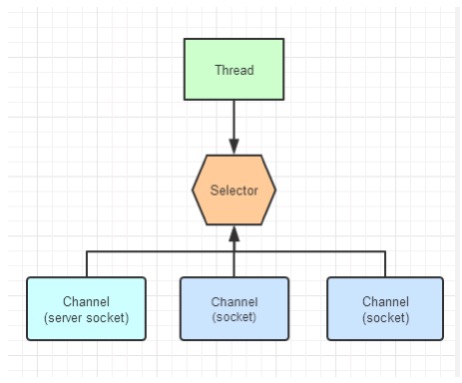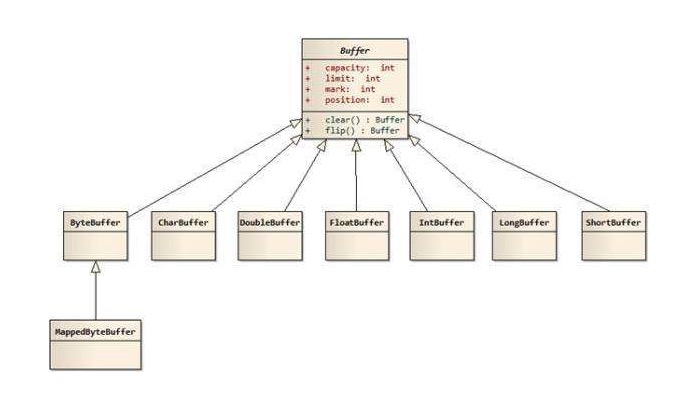前面一篇中已经介绍了基本IO的使用以及最简单的阻塞服务器的例子,本篇就来介绍下NIO的相关内容,前面的分享可以参考目录:
NIO,也叫做new-IO或者non-blocking-IO,就暂且理解为非阻塞IO吧。
为什么选择NIO
那么NIO相对于IO来说,有什么优势呢?总结来说:
- IO是面向流的,数据只能从一端读取到另一端,不能随意读写。NIO则是面向缓冲区的,进行数据的操作更方便了
- IO是阻塞的,既浪费服务器的性能,也增加了服务器的风险;而NIO是非阻塞的。
- NIO引入了IO多路复用器,效率上更高效了。
NIO都有什么

那么NIO都提供了什么呢?
- 基于缓冲区的双向管道,Channel和Buffer
- IO多路复用器Selector
- 更为易用的API

Buffer的使用
在NIO中提供了各种不同的Buffer,最常用的就是ByteBuffer:

可以看到,他们都有几个比较重要的变量:
- capacity——容量,这个值是一开始申请就确定好的。类似c语言申请数组的大小。
- limit——剩余,在写模式下初始的时候等于capacity;在读模式下,等于最后一次写入的位置
- mark——标记位,标记一下position的位置,可以调用reset()方法回到这个位置。
- posistion——位置,写模式下表示开始写入的位置;读模式下表示开始读的位置
总结来说,NIO的Buffer有两种模式,读模式和写模式。刚上来就是写模式,使用flip()可以切换到读模式。

关于这几个位置的使用,可以参考下面的代码:
public class ByteBufferTest {
public static void main(String[] args) {
ByteBuffer buffer = ByteBuffer.allocate(88);
System.out.println(buffer);
String value = "Netty权威指南";
buffer.put(value.getBytes());
System.out.println(buffer);
buffer.flip();
System.out.println(buffer);
byte[] v = new byte[buffer.remaining()];
buffer.get(v);
System.out.println(buffer);
System.out.println(new String(v));
}
}
得到的输出为:
java.nio.HeapByteBuffer[pos=0 lim=88 cap=88]
java.nio.HeapByteBuffer[pos=17 lim=88 cap=88]
java.nio.HeapByteBuffer[pos=0 lim=17 cap=88]
java.nio.HeapByteBuffer[pos=17 lim=17 cap=88]
Netty权威指南
读者可以自己领会一下,这几个变量的含义。另外说明一点,如果遇到自己定义POJO类,就可以像这里的Buffer重载toString()方法,这样输出的时候就很方便了。
最后关于ByteBuffer在Channel中的使用,可以参考下面的代码:
public class BufferTest {
public static void main(String[] args) throws IOException {
String file = "xxxx/test.txt";
RandomAccessFile accessFile = new RandomAccessFile(file,"rw");
FileChannel fileChannel = accessFile.getChannel();
// 20个字节
ByteBuffer buffer = ByteBuffer.allocate(20);
int bytesRead = fileChannel.read(buffer);
// buffer.put()也能写入buffer
while(bytesRead!=-1){
// 写切换到读
buffer.flip();
while(buffer.hasRemaining()){
System.out.println((char)buffer.get());
}
// buffer.rewind()重新读
// buffer.mark()标记position buffer.reset()恢复
// 清除缓冲区
buffer.clear();
// buffer.compact(); 清楚读过的数据
bytesRead = fileChannel.read(buffer);
}
}
}
这样,就熟悉了Channel和ByteBuffer的使用。接下来,看看服务器中的应用吧。
NIO服务器例子
前面BIO的服务器,是来一个连接就创建一个新的线程响应。这里基于NIO的多路复用,可以这样写:
import java.io.IOException;
import java.net.InetSocketAddress;
import java.net.ServerSocket;
import java.nio.ByteBuffer;
import java.nio.channels.SelectionKey;
import java.nio.channels.Selector;
import java.nio.channels.ServerSocketChannel;
import java.nio.channels.SocketChannel;
import java.util.Iterator;
import java.util.Set;
public class PlainNioserver {
public void serve(int port) throws IOException {
// 创建channel,并绑定监听端口
ServerSocketChannel serverSocketChannel = ServerSocketChannel.open();
serverSocketChannel.configureBlocking(false);
ServerSocket ssocket = serverSocketChannel.socket();
InetSocketAddress address = new InetSocketAddress(port);
ssocket.bind(address);
//创建selector,并将channel注册到selector
Selector selector = Selector.open();
serverSocketChannel.register(selector, SelectionKey.OP_ACCEPT);
final ByteBuffer msg = ByteBuffer.wrap("Hi\\r\\b".getBytes());
for(;;){
try{
selector.select();
}catch (IOException e){
e.printStackTrace();
break;
}
Set<SelectionKey> readyKeys = selector.selectedKeys();
Iterator<SelectionKey> iterator = readyKeys.iterator();
while(iterator.hasNext()){
SelectionKey key = iterator.next();
iterator.remove();
try{
if(key.isAcceptable()){
ServerSocketChannel server = (ServerSocketChannel)key.channel();
SocketChannel client= server.accept();
client.configureBlocking(false);
client.register(selector, SelectionKey.OP_WRITE | SelectionKey.OP_READ, msg.duplicate());
System.out.println("accepted connection from "+client);
}
if(key.isWritable()){
SocketChannel client = (SocketChannel) key.channel();
ByteBuffer buffer = (ByteBuffer) key.attachment();
while(buffer.hasRemaining()){
if(client.write(buffer)==0){
break;
}
}
client.close();
}
}catch (IOException e){
key.cancel();
try{
key.channel().close();
} catch (IOException ex){
ex.printStackTrace();
}
}
}
}
}
public static void main(String[] args) throws IOException {
PlainNioServer server = new PlainNioServer();
server.serve(5555);
}
}
这里抽象来说是下面的步骤:

- 创建ServerSocketChannel并绑定端口
- 创建Selector多路复用器,并注册Channel
- 循环监听是否有感兴趣的事件发生selector.select();
- 获得事件的句柄,并进行处理
其中Selector可以一次监听多个IO处理,效率就提高很多了。